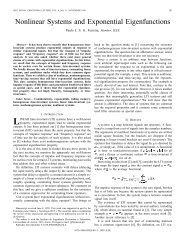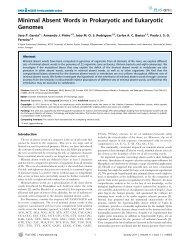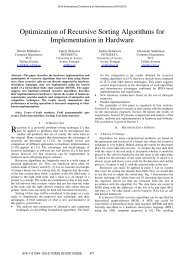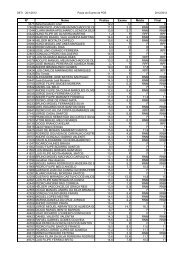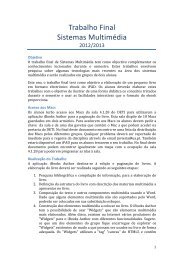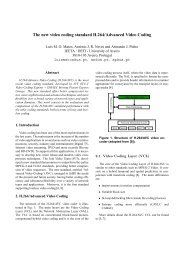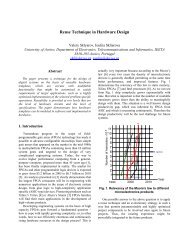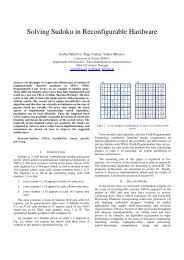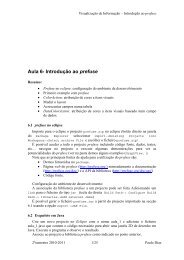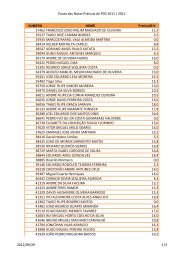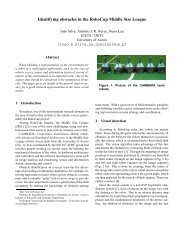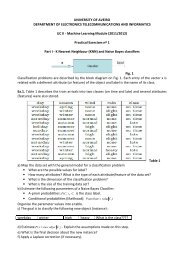DATA SHEET - IEETA
DATA SHEET - IEETA
DATA SHEET - IEETA
Create successful ePaper yourself
Turn your PDF publications into a flip-book with our unique Google optimized e-Paper software.
Philips Semiconductors Product specification<br />
8-bit microcontroller with on-chip CAN P8xC592<br />
22.1.2 CALCULATING THE MAXIMUM BIT-TIME<br />
Table 93 Example for calculating the maximum bit-time<br />
STATEMENT COMMENTS<br />
tMAX TRANSFER TIME = 10 ms assumption<br />
n<strong>DATA</strong> BYTES, WORST CASE = 6 longest message in that network; assumption<br />
n<strong>DATA</strong> BYTES = 4 ‘our message’; assumption<br />
nBIT MAX LATENCY ≤ 130 using Equation (3) and (4)<br />
nMESSAGE ≤ 92 using Equation (2)<br />
10 ms<br />
tBIT ≤ ----------------------------- =<br />
( 130 + 92)<br />
0.045 ms = 45 μs<br />
using Equation (1)<br />
22.2 Connecting a P8xC592 to a bus line<br />
(physical layer)<br />
22.2.1 ON-CHIP TRANSCEIVER<br />
The P8xC592 features an on-chip differential transceiver<br />
including output driver and input comparator both being<br />
configurable (see Fig.36). Therefore it supports many<br />
types of common transmission media such as:<br />
• Single-wire bus line<br />
• Two-wire bus line (differential)<br />
• Optical cable bus line.<br />
The P8xC592 can directly drive a differential bus line.<br />
An example is given in Fig.37 for a bus line having a<br />
characteristic impedance of 120 Ω. Direct interfacing to<br />
the bus line is well suited for applications with limited<br />
requirements concerning electromagnetic susceptibility,<br />
wiring failure tolerance and protection against transients.<br />
22.2.2 TRANSCEIVER FOR IN-VEHICLE COMMUNICATION<br />
Fig.38 shows a versatile transceiver implementation<br />
designed for automotive applications. It features a bit rate<br />
of up to 1 Mbit/s and dissipates low power during standby<br />
(1.4 mA). Thus it is suitable also for applications requiring<br />
a Sleep mode function with system activation via the bus<br />
line. The transceiver provides and extended common<br />
mode range for high electromagnetic susceptibility<br />
performance.<br />
Two external driver transistors amplify the output current<br />
to 35 mA typically and provide protection against<br />
overvoltage conditions on the bus line (e.g. due to an<br />
accidental short-circuit between a bus wire and battery<br />
voltage). The serial diodes prevent in combination with the<br />
transistors the bus from being blocked in case of a bus not<br />
powered. More than 32 nodes may be connected to the<br />
bus line.<br />
1996 Jun 27 92<br />
22.2.3 DETECTION AND HANDLING OF BUS WIRING<br />
FAILURES<br />
Using the P8xC592 a superior wiring failure tolerance and<br />
detection performance can be achieved. This requires<br />
both bus lines to be mutually decoupled as shown in<br />
Fig.39. Each bus wire is based separately to a reference<br />
voltage of 1 ⁄2AVDD.<br />
The diodes suppress reverse current in case of a<br />
termination circuit being not properly powered or a bus line<br />
being short i.e. to a voltage higher than 5 V. Applying this<br />
bus termination circuit the following wiring failures on the<br />
bus are detectable and can be handled:<br />
• Interruption of one bus wire at any location.<br />
• Short-circuit of one bus wire to ground or battery<br />
voltage.<br />
• Short-circuit between the bus wires.<br />
A bus failure can be detected e.g. by a drop out of a status<br />
message, regularly being transmitted on the bus. If a bus<br />
wire is corrupted the following actions have to be taken:<br />
• Switch the corresponding comparator input over to a<br />
reference voltage of 1 ⁄2AVDD.<br />
• Disable the corresponding output driver stage.<br />
As a consequence communication will continue on that<br />
bus wire not being corrupted. The required reference<br />
voltage and the switches for the comparator inputs are<br />
provided on-chip. An output driver stage can be disabled<br />
by reconfiguration of the on-chip output driver<br />
(reprogramming of the Output Control Register of the<br />
P8xC592; see Section 13.5.11, Table 51). To find out<br />
which of the bus wires is corrupted a heuristic method is<br />
applied.



